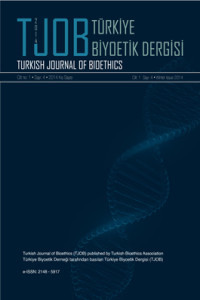Bronkoskopi İşleminde Video Bilgilendirmenin Aydınlatılmış Onam ve Anksiyete Üzerine Etkisi
GİRİŞ ve AMAÇ: Hastane ortamının yabancılığı ve yalnızlığı, tanımadığı kişilerle iletişim kurma zorunluluğu, hekimlerin kullandığı anlaşılması zor tıbbi dil, daha önceden aynı konuda bireysel deneyiminin olmaması, bilgi noksanlığı, eksik ve/veya yanlış duyumlar ve dahası beden bütünlüğünün bozulma kaygısı gibi nedenlerden dolayı herhangi bir girişimsel işlem uygulanması planlanan hastaların işlem öncesinde anksiyete düzeyleri yüksektir. Hiç kuşku yok ki bu yüksek kaygı düzeyi, hastaların motivasyonlarını, yapılacak işleme ve/veya tedaviye özgürce karar verme iradelerini ve işlem ve/veya tedaviye uyumlarını olumsuz etkilemektedir. Gerek Türkçe gerekse İngilizce literatürde göğüs hastalıkları alanında invaziv girişim olarak çok sık kullanılan ve hastalarda önemli derecede anksiyeteye neden olan bronkoskopi işlemi hakkında video bilgilendirmenin hastanın aydınlatılması ve anksiyetesi üzerine olan etkisini araştıran bir çalışmanın olmaması nedeni ile bu araştırma medikal literatürdeki eksikliği gidermeye yönelik olarak yapıldı.
YÖNTEM ve GEREÇLER: Çalışma bünyesinde araştırmaya katılmayı kabul eden hastalar “zarf çekme” yöntemine göre Yazılı ve Sözlü Bilgilendirme Grubu, Yazılı, Sözlü ve Video Bilgilendirme Grubu ve Video Bilgilendirme Grubu olarak üç gruba randomize edildi. Araştırma verileri hastaların sosyodemografik bilgileri, bilgilendirme öncesi ve sonrası bronkoskopi bilgi anketleri, bilgilendirme öncesi ve sonrası Durumluk Kaygı Ölçeği (STAI), bronkoskopi öncesi ve sırasındaki vital bulguları, bronkoskopi sonrası hekim ve hasta değerlendirme formlarından elde edildi.
BULGULAR: Yapılan analizlerde bronkoskopi işleminin hastalarda kaygı ve korkuya yol açtığı, video bilgilendirme yönteminin yazılı-sözlü bilgilendirme yöntemine kıyasla bu kaygı ve korkuları daha çok azalttığı; özellikle acı konusunda hastalarda gelişen hatalı algı ve korkuları düzeltme açısından diğer yönteme kıyasla anlamlı oranda başarılı olduğu; benzer biçimde video bilgilendirme yönteminin hastaların anksiyete puanlarını anlamlı oranda azalttığı, onları endişe-heyecandan kurtardığı ve bu nedenle bronkoskopi işlemi esnası ve sonrasında otonom sinir sistemi yanıtlarının neden olacağı taşikardi, takipne ve hipertansiyon gibi istenmeyen etkilerden koruduğu ve hastaları daha çok soru sorma ve sorgulamaya yönelttiği saptanmıştır.
TARTIŞMA ve SONUÇ: Video bilgilendirme yöntemi, bronkoskopinin neden olduğu anksiyeteyi azaltmada ve hastayı onam açısından bilgilendirmede yazılı-sözlü bilgilendirmeden anlamlı olarak daha üstündür.
Anahtar Kelimeler:
Bronkoskopi, aydınlatılmış onam, anksiyete
INTRODUCTION: Due to the reasons, such as the alienage and the loneliness of the hospital environment, the obligation for setting up communication with unacquainted people, the medical language of the doctors which is difficult to understand, the lack of personal experience in the same matter, lack of knowledge, lacked and/ or incorrect over-hearings, and more than these, the worry about the disturbance to the body completeness, The anxiety levels of the patients who are planned to be applied an interventional operation are high before the operation. Undoubtedly, these high anxiety levels affect their motivation, their will to decide the operation and/or treatment freely, and their compliance with the operation and/or treatment. This study was done based on prospective observation, towards the need for the resolution of the lack in medical literature because of the nonexistence of a study searching for the effect of a video informing about bronchoscope operation, which is highly frequently used on patients as an invasive operation in the field of chest diseases in both Turkish and English literature, and which causes significant degrees of anxiety
METHODS: Patients accepting to participate in the study were randomized into three groups according to the “envelope pulling” method, as “the Written and Orally Informed Group”, “Written, Oral and Video Informed Group”, and “Video Informed Group”. The data were optain by piling up the socio-demographic information of the patients, the bronchoscopy information surveys done both before and after informing, State Anxiety Scale (Indicator)(STAI) before and after informing, vital findings before and during the bronchoscopy, and doctor and patient evaluation forms after the bronchoscopy.
RESULTS: In the analysis, it was determined that the bronchoscope operation caused anxieties and fears in patients, that the video informing method decreased these anxieties and fears far more than informing orally and written method, that it was significantly more successful than the other method in respect for eliminating the wrong perceptions and fears developing in the patients especially in pain matter. Similarly, it was also determined that the video informing method decreased the anxiety points of the patients, rescued them from worry and excitement, and for this reason, protected them from undesired effects such as tachycardia, tachypnea and hypertension, which autonomous nerve system might cause during and after the bronchoscope operation, and that it directed the patients towards asking questions and inquiring more.
DISCUSSION AND CONCLUSION: Video information method is significantly superior to written-verbal information in reducing anxiety caused by bronchoscopy and informing the patient in terms of consent.
Keywords: Bronchoscopy, informed consent, anxiety
Keywords:
Bronchoscopy, informed consent, anxiety,
- ISSN: 2148-5917
- Yayın Aralığı: Yılda 4 Sayı
- Başlangıç: 2014
- Yayıncı: Türkiye Biyoetik Derneği
